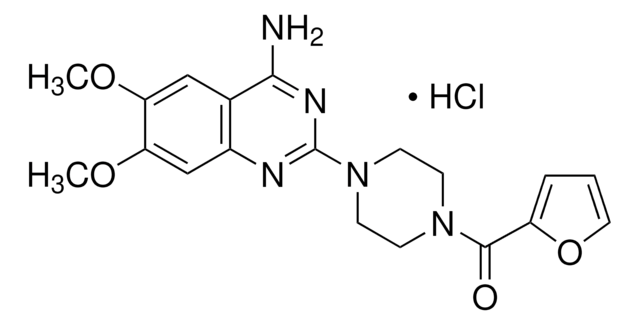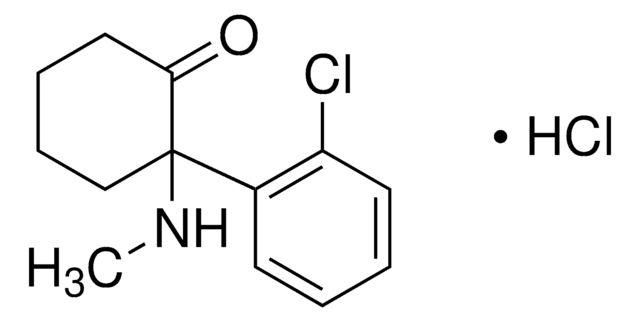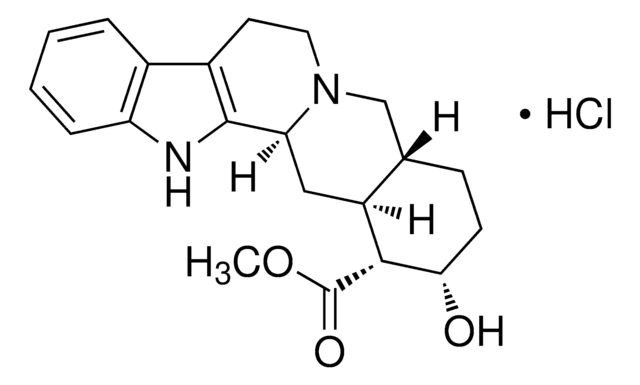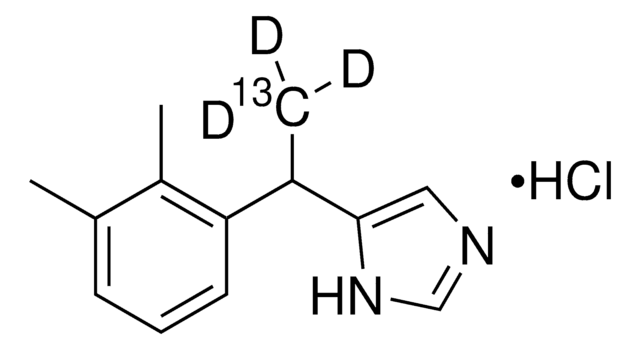A9611
Atipamezole
≥98% (HPLC)
Synonym(s):
4-(2-Ethyl-2,3-dihydro-1H-inden-2-yl)-1H-Imidazole, Antisedan, MPV 1248
Sign Into View Organizational & Contract Pricing
All Photos(1)
About This Item
Empirical Formula (Hill Notation):
C14H16N2
CAS Number:
Molecular Weight:
212.29
MDL number:
UNSPSC Code:
12352200
PubChem Substance ID:
NACRES:
NA.77
Recommended Products
Assay
≥98% (HPLC)
form
powder
color
white to brown
solubility
DMSO: ≥30 mg/mL
storage temp.
room temp
SMILES string
CCC1(Cc2ccccc2C1)c3c[nH]cn3
InChI
1S/C14H16N2/c1-2-14(13-9-15-10-16-13)7-11-5-3-4-6-12(11)8-14/h3-6,9-10H,2,7-8H2,1H3,(H,15,16)
InChI key
HSWPZIDYAHLZDD-UHFFFAOYSA-N
General description
Atipamezole has an imidazole structure and gets localized in the central nervous system on administration.
Application
Atipamezole has been used as a α2-adrenoceptor antagonist in mesencephalic trigeminal nucleus (MTN) neurons, CD4+ T-lymphocyte and human embryonic kidney (HEK293) membrane preparation.
Biochem/physiol Actions
Atipamezole elicits affinity towards adrenoreceptor subtypes namely α2A, α2B and α2C. High levels of atipamezole impairs cognitive functions. It also reverses the adrenoreceptor agonist functionalities. Atipamezole shows no affinity towards muscarinic and dopamine or neurotransmitter receptors. Atipamezole when used along with morphine elicits antinociceptive effects.
Atipamezole is a selective α2 adrenergic blocker. Atipamezole is more potent than yohimbine; it is very selective for α2 adrenergic vs α1 sites, but not selelctive for α2 subtypes.
Atipamezole is a selective α2 adrenergic blocker; neutral antagonist
Features and Benefits
This compound is a featured product for Neuroscience research. Click here to discover more featured Neuroscience products. Learn more about bioactive small molecules for other areas of research at sigma.com/discover-bsm.
This compound is featured on the α2-Adrenoceptors page of the Handbook of Receptor Classification and Signal Transduction. To browse other handbook pages, click here.
Storage Class Code
11 - Combustible Solids
WGK
WGK 3
Flash Point(F)
Not applicable
Flash Point(C)
Not applicable
Choose from one of the most recent versions:
Already Own This Product?
Find documentation for the products that you have recently purchased in the Document Library.
Tuomas O Lilius et al.
Anesthesia and analgesia, 114(6), 1353-1358 (2012-05-05)
Opioid analgesics are effective in the treatment of chronic pain, but they have serious adverse effects such as development of tolerance and dependence. Adrenergic α(2) agonists and μ-opioid receptor agonists show synergistic potentiation and cross-tolerance in spinal analgesia, whereas α(2)-adrenergic
D Van Vynckt et al.
The Journal of small animal practice, 52(12), 638-644 (2011-10-25)
To assess the influence of two sedation protocols on the degree of lameness in dogs. Fifty lame dogs were allocated to one of two sedation protocols. Group ACPM (acepromazine + methadone; n=25) was sedated with acepromazine and methadone. Group MED
Hong Wei et al.
Basic & clinical pharmacology & toxicology, 112(2), 90-95 (2012-08-21)
Pontine A5, A6 (locus coeruleus) and A7 cell groups provide noradrenergic innervation of the spinal cord. Here, we assessed whether activation of α(2) -adrenoceptors in A7 influences peripheral nerve injury-induced hypersensitivity in the rat, and whether spinal α(2) -adrenoceptors mediate
Michele Barletta et al.
Journal of the American Veterinary Medical Association, 238(9), 1159-1167 (2011-05-03)
To compare efficacy and cardiorespiratory effects of dexmedetomidine and ketamine in combination with butorphanol, hydromorphone, or buprenorphine (with or without reversal by atipamezole) in dogs undergoing castration. Prospective, randomized, split-plot, blinded study. 30 healthy client-owned sexually intact male dogs. Dogs
Andrew P Woolnough et al.
Journal of wildlife diseases, 48(2), 435-443 (2012-04-12)
The Judas technique is a method used for landscape control of feral donkeys (Equus asinus) in northern Australia. Central to the success of any Judas program is the safe, efficient, and humane attachment of the telemetry device. For feral donkeys
Articles
α2-Adrenoceptors
Our team of scientists has experience in all areas of research including Life Science, Material Science, Chemical Synthesis, Chromatography, Analytical and many others.
Contact Technical Service






